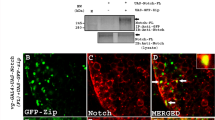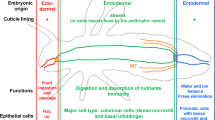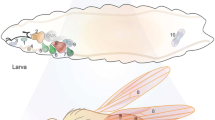Abstract
The homeobox (Hox) genes constitute an evolutionarily conserved family encoding transcription factors which play major roles in segmental identity and organ specification, across species. The expression patterns of three Hox genes, Antennapedia (Antp), Ultrabithorax (Ubx) and even-skipped (eve) were analyzed during silk gland development in Bombyx mori. Antp followed a middle silk gland (MSG) restricted pattern of expression, whereas Ubx was specifically expressed in the posterior silk gland (PSG) during embryonic and larval developmental stages. Eve protein, on the other hand, was expressed in both MSG and PSG. We have also identified and characterized a novel Pax-like mRNA that is expressed exclusively in the PSGs during embryonic and larval development. The expression of Antp, Ubx and Pax-like reached maximum levels in the fifth larval intermoult and no expression was detected during the intervening moults. The region-specific expression of certain Hox genes appears to be responsible for the specification of silk gland compartments, whereas other Hox genes may play a global role in controlling the expression of genes encoding silk proteins.









Similar content being viewed by others
References
Alonso CR, Maxton-Kuechenmeister J, Akam M (2001) Evolution of Ftz protein function in insects. Curr Biol 11:1473–1478
Andrew DJ, Henderson KD, Seshaiah P (2000) Salivary gland development in Drosophila melanogaster. Mech Dev 92:5–17
Botas J, Auwers L (1996) Chromosomal binding sites of Ultrabithorax homeotic proteins. Mech Dev 56:129–138
Chi N, Epstein JA (2002) Getting your Pax straight: Pax proteins in development and disease. Trends Genet 18:41–47
Chomczynski P, Sacchi N (1987) Single-step method of RNA isolation by acid guanidinium isothiocyanate-phenol-chloroform extraction. Anal Biochem 162:156–169
Damen WG, Tautz D (1998) A Hox class 3 orthologue from the spider Cupiennius salei is expressed in a Hox-gene-like fashion. Dev Genes Evol 208:586–590
Dhawan S, Gopinathan KP (2002) Molecular cloning and expression pattern of a Cubitus interruptus homologue from the mulberry silkworm Bombyx mori. Mech Dev 118:203–207
Dhawan S, Gopinathan KP (2003) Expression pattern of Cubitus interruptus from the mulberry silkworm Bombyx mori in late developmental stages. Dev Genes Evol 213:166-177
Gibson G. (2000) Evolution: Hox genes and the cellared wine principle. Curr Biol 10:R452–R455
Henderson KD, Andrew DJ (2000) Regulation and function of Scr, exd, and hth in the Drosophila salivary gland. Dev Biol 217:362–374
Hughes C, Kaufman TC (2002) Hox genes and the evolution of the arthropod body plan. Evol Dev 4:459–499
Hui CC, Suzuki Y, Kikuchi Y, Mizuno S (1990a) Homeodomain binding sites in the 5′ flanking region of the Bombyx mori silk fibroin light-chain gene. J Mol Biol 213:395–398
Hui CC, Matsuno K, Suzuki Y (1990b) Fibroin gene promoter contains a cluster of homeodomain binding sites that interact with three silk gland factors. J Mol Biol 213:651–670
Hui CC, Matsuno K, Ueno K, Suzuki Y (1992) Molecular characterization and expression patterns of Bombyx engrailed and invected genes. Proc Natl Acad Sci USA 89:161–171
Jones NA, Kuo YM, Sun YH, Beckendorf SK (1998) The Drosophila Pax gene eye gone is required for embryonic salivary duct development. Development 125:4163–4174
Julien E, Bordeaux MC, Garel A, Couble P (2002) Fork head alternative binding drives stage-specific gene expression in the silk gland of Bombyx mori. Insect Biochem Mol Biol 32:377–387
Kaufman TC, Seeger MA, Olsen G (1990) Molecular and genetic organization of the antennapedia gene complex of Drosophila melanogaster. Adv Genet 27:309–362
Kokubo H, Takiya S, Mach V, Suzuki Y (1996) Spatial and temporal expression pattern of Bombyx fork head/ SGF-1 gene in embryogenesis. Dev Genes Evol 206:80–85
Kokubo H, Ueno K, Amanai K, Suzuki Y (1997) Involvement of the Bombyx Scr gene in development of the embryonic silk gland. Dev Biol 186:46–57
Lewis EB (1978) A gene complex controlling segmentation in Drosophila. Nature 276:565–570
Lohr U, Yussa M, Pick L (2001) Drosophila fushi tarazu: a gene on the border of homeotic function. Curr Biol 11:1403–1412
Mase K, Yamamoto T, Hara W (1994) Localization of Bm-Antennapedia mRNAs in Bombyx embryos by whole-mount in situ hybridization. J Sericult Sci Jpn 63:194–200
Mastick GS, McKay R, Oligino T, Donovan K, Lopez AJ (1995) Identification of target genes regulated by homeotic proteins in Drosophila melanogaster through genetic selection of Ultrabithorax protein-binding sites in yeast. Genetics 139:349–363
Nagata T, Suzuki Y, Ueno K, Kokubo H, Xu X, Hui CC, Hara W, Fukuta M (1996) Developmental expression of the Bombyx Antennapedia homologue and homeotic changes in the Nc mutant. Genes Cell 1:555–568
Sambrook J, Frisch EF, Maniatis T (1989) Analysis of genomic DNA by Southern hybridization. In: Nolan C (ed) Molecular cloning: a laboratory manual. Cold Spring Harbor Laboratory Press, Cold Spring Harbor, N.Y., pp 9.31–9.58
Sanchez-Herrero E, Vernos I, Marco R, Morata G (1985) Genetic organization of Drosophila bithorax complex. Nature 313:108–113
Singh A, Gopinathan KP (1997) Analysis of gene expression during embryonic development in mulberry silkworm Bombyx mori. Curr Sci 72:214–218
Sudhakar B, Gopinathan KP (2000) Expression of cyclin E in endomitotic silk-gland cells from mulberry silkworm. Gene 257:77–85
Takami T, Kitazawa T (1960).Normal stages of embryonic development in the silkworm, Bombyx mori. Tech Bull Sericult Exp Stn 75:1–-31
Telford MJ, Thomas RH (1998) Of mites and zen: expression studies in a chelicerate arthropod confirm zen is a divergent Hox gene. Dev Genes Evol 208:591–594
Thompson JD, Higgins DG, Gibson TJ (1994) Clustal W: improving the sensitivity of progressive multiple sequence alignment through sequence weighting, position specific gap penalties and weight matrix choice. Nucleic Acid Res 22:4673–4680
Ueno K, Hui CC, Fukuta M, Suzuki Y (1992) Molecular analysis of deletion mutants in in the E homeotic complex in the silkworm Bombyx mori. Development 114:555–563
Valentine JW, Erwin DH, Jablonski D (1996) Developmental evolution of metazoan body plans: the fossil evidence. Dev Biol 173:373–381
Acknowledgements
We thank Dr. L.S. Shashidhara, CCMB, Hyderabad for anti-Ubx antibodies and the Central Silk Research and Training Institute (CSB), Mysore, for the supply of silkworm embryos and larvae. S.D. is a recipient of a Senior Research Fellowship from CSIR, New Delhi and K.P.G. is a CSIR Emeritus Scientist. We thank the Department of Biotechnology, Govt. of India, for financial support.
Author information
Authors and Affiliations
Corresponding author
Additional information
Edited by D. Tautz
Rights and permissions
About this article
Cite this article
Dhawan, S., Gopinathan, K.P. Expression profiling of homeobox genes in silk gland development in the mulberry silkworm Bombyx mori . Dev Genes Evol 213, 523–533 (2003). https://doi.org/10.1007/s00427-003-0357-1
Received:
Accepted:
Published:
Issue Date:
DOI: https://doi.org/10.1007/s00427-003-0357-1




